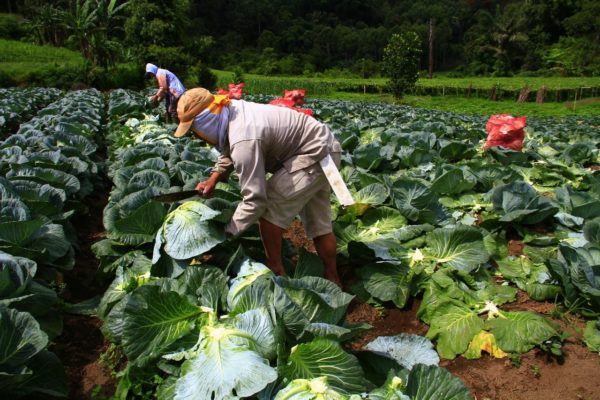Migration & Drought Threaten Farming in Nicaragua & Honduras

The decrease in agricultural production, reflected in official government data from both countries, will affect the region’s food security.
HAVANA TIMES – Both Nicaragua and Honduras registered a drop in agricultural production for the months of June and July of 2024, according to data from the Monthly Economic Activity Index (IMAE).
The variable climate and the scarcity of labor due to the high rate of emigration from both countries are the two main reasons for the decrease in agriculture, according to both the Central Bank of Honduras and the Central Bank of Nicaragua.
Year-to-year agricultural production in Nicaragua decreased 3.8% in 2023 and continues falling in 2024. Economists from the organization Business Development Consultants commented that the behavior of agriculture should be watched closely.
Honduras has lost 446,643 jobs in the agricultural sector over the last five years, according to the Honduran National Statistics Institute. From 2023 to 2024, the Honduran Central Bank indicated that economic activity in agricultural production showed a relative drop of 1.7%.
Decrease in traditional agriculture
As of June 2024, Nicaragua reported a 1.0% drop in production to the IMAE, due to decreased production of coffee, sorghum, sesame, and banana crops. Meanwhile, as of May 2024, Honduras reflected a 2.1% decrease in agriculture, and a decrease in coffee and African palm production specifically, due to climatic factors and irregular emigration.
Projections for the performance of other important crops, such as corn, are not encouraging either. Corn yields in 2025 could fall by 17.7% in Nicaragua and 16.2% in Honduras, if labor, emigration, and climate conditions are not counteracted by adaptative measures, according to the International Maize and Wheat Improvement Center.
Nicas and Hondurans are leaving the countryside to emigrate
Honduras and Nicaragua are countries where, historically, a significant percentage of the population has chosen to emigrate. For decades, hundreds of thousands of people have left both countries, mainly in search of better job opportunities and greater stability.
It’s estimated that, currently, more than 20% of the Nicaraguan population has emigrated. Nicaraguan migration increased dramatically in 2018, due to the socio-political crisis in the country. In 2022, more than 300 000 Nicaraguans left the country. The trend continued in 2023, with the departure of 115 000 more Nicaraguans, mainly to the United States and Costa Rica, according to data from Manuel Orozco. a specialist in migration issues and remittances, and a researcher at Inter-American Dialogue.
Meanwhile, Honduras has registered an 18% rate of emigration among its population, according to the 2023 National Survey of Migration and Remittances. The National Statistics Institute of Honduras explains that 3% of the population also report internal displacement, meaning they’ve been forced to change their normal place of residence to some other part of Honduras in the last 5 years, principally from the countryside to the cities. It’s been estimated that 348,445 Hondurans have left the country in the last five years, most of them to the United States or Spain.
According to the International Maize and Wheat Improvement Center, the growth in migration from 1990 to 2020 in both Central American countries, “suggests a response to the lack of opportunities in the countryside and has led to a labor shortage in the sector, thus driving up production costs and reducing production.”
“The emigration reduces the number of available workers, which can affect agricultural production, especially during the harvest seasons,” noted the Honduran Foreign Ministry upon being consulted by Confidencial.
The Ministry spokesperson added that the exit of Hondurans affects the families in the rural areas, leaving the communities without young people who could contribute to the agricultural labor force. This increases the pressure on those who remain, such as the women and older people, to maintain the production, the Honduran Foreign Ministry indicated.
“El Niño” years bring diminished agricultural production
The El Niño climate phenomenon caused shortages across the Central American dry corridor in 2023. The World Food Program (WFP) estimated that 486,000 people in the four countries of the dry corridor (Honduras, Nicaragua, El Salvador, and Guatemala) were exposed to severe drought that year. Consequently, the WFP “predicts that between 1.7 and 2.7 million people will need food assistance in El Salvador, Guatemala, Honduras and Nicaragua.”
Hector Ferreira, president of the National Federation of Farmers and Ranchers of Honduras, indicated that climate change has also contributed to the loss of employment in the Honduran countryside. Agricultural land accounts for the employment of almost 39% of the country’s population. After the pandemic, the sector has slowly recovered, to the point that it now accounts for 847,908 jobs. However, it falls short of the levels recorded for 2019, when agriculture employed 1,212,269 workers.
The migration of workers experienced in crop management and agricultural techniques also means less capacity to respond and adapt to climate change, added the Honduran Foreign Ministry.
In Nicaragua, the 2023-4 agricultural cycle was affected by the El Niño phenomenon, characterized by scarce rainfall and high temperatures that affected the expected yields and total agricultural production, stated the Central Bank of Nicaragua.
Less rainfall and fewer workers in the countryside means less agricultural production for sale, and less for the producers’ family consumption. The International Maize and Wheat Improvement Center notes in its study that approximately 5.8 million people are suffering severe food insecurity in Guatemala, Honduras, and El Salvador according to data from the Central American Integration System. This, in turn, sparks further emigration from these countries.
“The migratory flows out of the region increased drastically after the peak of the pandemic, with hundreds of thousands of people in these countries affected by crisis. They then head north, in an attempt to reach the United States by way of Mexico, remarked Bram Govaerts, general director of the International Maize and Wheat Improvement Center, regarding the region’s food insecurity.





